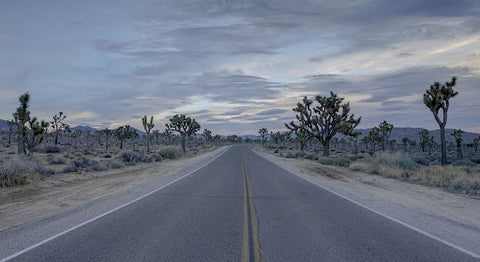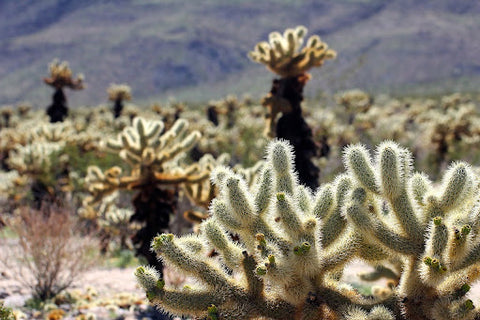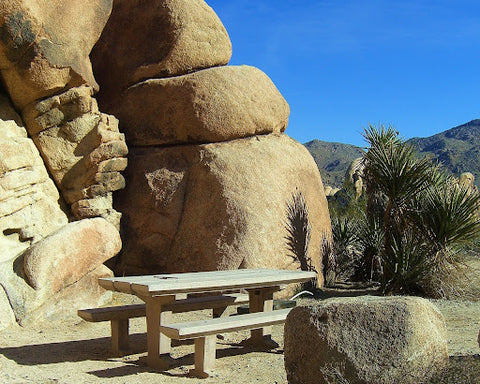RVing in Joshua Tree National Park
If you find yourself driving through southeastern California on your next road trip, it’s worth stopping at Joshua Tree National Park. This desert wilderness attracts RVers from all over the country for its unique rock structures, cacti and wildflowers, stunning sunrises and sunsets, and twisted, spiky trees that are native to the area—known as Joshua trees.
This park is a quiet, open space that covers almost 800,000 acres of land. Its remote, peaceful environment makes it worth stopping at on your adventure. Here’s everything you need to know about exploring Joshua Tree National Park in your RV.

Reasons to Visit Joshua Tree National Park
Joshua Tree National Park is rich in history. Joshua trees were recognized by natives for their useful properties. Strong leaves were used to create baskets and sandals and flower buds and seeds were collected for food. What’s more, ranchers used the limbs and trunks for fencing and corrals and miners found that these trees could be used for steam engine fuel and processing ore.
The park has two distinct desert areas—the High Mojave Desert, known for its abundance of Joshua trees, and the low Colorado Desert, where plant species like the ocotillo and smoke tree can be found. The Mojave Desert is the only area where these trees go naturally. They range anywhere from 14 to 40 feet tall and can live up to 150 years. In addition to exploring these distinct trees, visitors may spot wildlife, such as lizards, coyotes, and desert tortoises. On the east side of the park, the dark night sky brings out an abundance of stars.
Know Before You Go
The highest elevation in the park is the summit of Quail Mountain at 5,816 feet and the lowest is in the southeastern boundary at 536 feet. This means that the weather can fluctuate in different areas, so be sure to bring layers. In the summer, temperatures can rise over 100 degrees Fahrenheit and there is very little shade, so bringing extra water is necessary. The most popular time to visit the park is in the fall and spring since temperatures are more comfortable.
There are no gas stations in the park, so be sure to fill up your gas tank prior to entering the park. There are three surrounding towns you can stop in for gas, snacks, and other essentials: Joshua Tree, Twentynine Palms, or Yucca Valley.

Things to Do in Joshua Tree National Park
With so much to explore in the park, you may not know where to begin. Rock climbers, whether beginner or expert, can explore over 8,000 easy-to-extreme vertical rock walls. Hikers can view Joshua trees, oasis, and mountain views up close. Those who simply want to drive through can take in everything this landscape has to offer.
If you’re looking for a few easy trails to explore in the park, check out the Cholla Cactus Garden during sunrise or sunset for what feels like an infinite view of cholla cactus. In addition, Heart Rock is a short walk on Arch Rock Trail, which brings you to a rock formation that you’ll absolutely love. You can also take the popular and easy 1.7-mile trail to Skull Rock to view the skull-looking rock that was formed by repeated rock erosion and water accumulation overtime.
For something a bit more strenuous, trek to Ryan Mountain, where you can immerse yourself in unique rock formations and get 360 views of the park. Another popular spot is the moderate, 3.1-mile hike to Fortynine Palms Oasis, known for its desert landscape with enough water for several plant species to thrive.
If you’re just driving through Joshua Tree National Park and don’t intend on traveling far from your RV, you can check out Keys View, which offers amazing views of the Coachella Valley, Mount San Jacinto, Mount Gorgonio, and the Salton Sea. You can also view spots like Skull Rock and Ryan Mountain right from your RV by driving down Park Boulevard.

Where to Stay Joshua Tree National Park
Joshua Tree National Park has eight campgrounds and over 500 campsites total. Five of them take reservations up to six months in advance and three operate on a first-come, first-serve basis. During holidays and busy months, reservations are recommended.
No campgrounds in the park offer hookups. The Black Rock and Cottonwood Campgrounds have potable water and dump stations. At the Hidden Valley and White Tank Campgrounds, RVs and trailers can’t exceed a length of 25 feet. Other campgrounds won’t allow RV’s and trailers longer than 35 feet unless otherwise specified.
Reservation Campgrounds
- Black Rock Campground
- Cottonwood Campground
- Indian Cove Campground
- Jumbo Rocks Campground
- Ryan Campground
First-Come, First-Serve Campgrounds
Whether you’re making your way southwest after exploring Arches National Park or are just trying to figure out where to go next, it’s worth exploring this unique landscape on your journey. There are several other RV-bucket-list-worthy destinations including wineries in California and beyond that you can add to your itinerary as well.
See you on the road!
